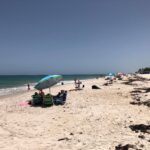By Sandra RawlsIndian River County — Spurning a $120,000 cash offer from the University of Florida, and pleas and invitations from the Smithsonian Institution, the American Museum of Natural History in New York and the Field Museum in Chicago, an amateur fossil hunter has decided to sell at public auction an etched 13,000-year-old fossil bone he found here in Vero Beach.
Discovery of the relic, which scientists say is the oldest authenticated artwork in the Americas, was first reported in a copyrighted story in the June 4, 2009 issue of our sister publication, Vero Beach 32963. Now, James Kennedy, who discovered the etching of an ancient elephant on a footlong fossil bone he had found several years ago, has signed a deal with longtime Vero real estate auctioneer and antiques dealer Ron Rennick Sr., who has paid him $10,000 for the right to offer the piece at absolute auction. Kennedy says he has heard estimates of the bone’s value ranging from $100,000 to well over $1 million.
Rennick, a Harvard-educated art collector, is working with the Vero Beach Museum of Art to hold an international auction and reception there in February. He says he intends to spend $40,000 on marketing to attract bidders to the event. The news of a public auction dismayed renowned Gainesville archaeologist Barbara Purdy, a retired professor at the University of Florida and a champion of the bone’s extraordinary significance since she first examined it this spring.
“Frankly, I’m sickened,” she said, saying she fears the bone could end up in the hands of a private collector who might keep it out of reach of archaeologists. So far, not even a cast has been made of the scientifically invaluable object.
In June, after hearing the opinions of a panel of scholars affirming the etching’s authenticity, Purdy declared the bone “the oldest, most spectacular and rare work of art in the Americas.”
The best outcome, in the view of many, is that a consortium of people might join forces to preserve the fossil for science and the public, perhaps alumni of the University of Florida who would buy the piece and donate it to the university for display in the Florida Museum of Natural History there.
Others have suggested the piece, as a work of art, belongs in the collection of the Vero Beach Museum of Art, which in turn could loan it to larger museums. According to Dr. Debra Krumm, former curator at Fort Pierce’s Harbor Branch Oceanographic Institution, an auction could become “a disaster for science” if the bone ends up in a private collection and is kept from researchers – and away from public view – forever.
Anxiety over traveling with the bone to such far-flung places as Washington and New York, and keen concern that the bone might be lost, stolen, or swindled away, drove Kennedy’s decision to sell the fossil through a local source.The fossil mammal bone bears the carving of an extinct elephant and has been determined to be at least 13,000 years old. The find, unlike anything he had discovered in 25 years of amateur fossil hunting, has created a sensation in the United States and elsewhere, and brought him attention he never dreamed of.
Along with dates, Rennick and museum officials say they still need to work out how bidding will be done without phone banks, which the museum is not prepared to provide.A collector of art and objects himself, Rennick approached Kennedy as early as May about conducting a local absolute auction of the bone. With a lifetime of experience with auctions, he presented proposals to Kennedy throughout the summer.
Rennick’s patience paid off, as Kennedy’s wore thin.
“Those big auction houses up north require a ton of paper work, which we did,” says a frustrated Kennedy. “But they also wanted me to send the thing all around to other experts so I’d have to travel everywhere. I trust what all those people have said at the University of Florida, but Ron’s been working real hard to convince me to go with him, so that’s what I’m doing.”
In the end, the world-famous institutions and auction houses failed to give Kennedy the plan of action he wanted. “This is one redneck down South who got tired of waiting,” he said.






